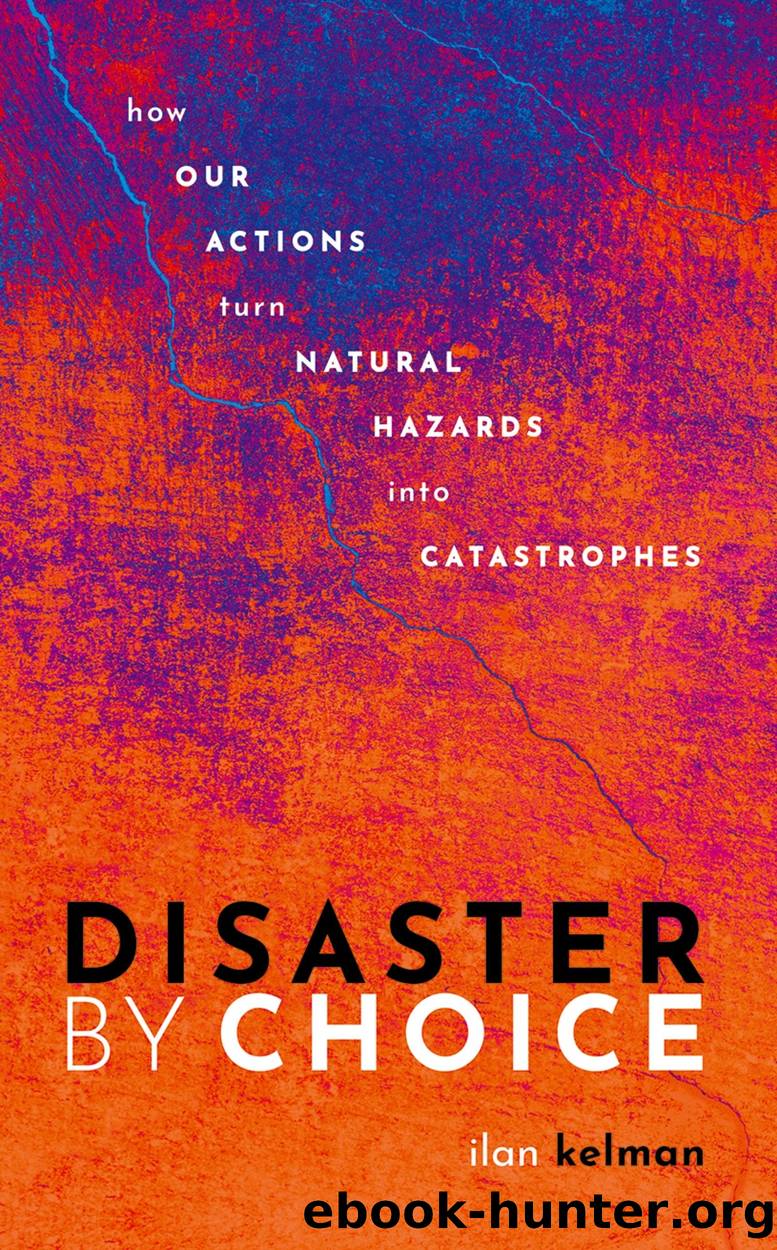Disaster by Choice by Ilan Kelman

Author:Ilan Kelman [Kelman, Ilan]
Language: eng
Format: epub
ISBN: 9780192578297
Publisher: OUP Oxford
Published: 2019-10-09T00:00:00+00:00
No Vulnerability is Inevitable
For the vast majority of the world’s population, full resources, choices, and opportunities are not available to tackle their disaster vulnerability. Others make decisions which impose vulnerability on the majority and stop them from dealing with it.
Resolving this situation involves identifying the people, groups, politics, power games, and social structures responsible for decisions that create disaster vulnerability. Sometimes, legal recourse is sought to establish blame, to enforce action, and to expand choices. Sometimes, the legal system itself creates vulnerability to disasters. Questions of ethics and ideology emerge, because many groups with power do not, when it comes down to it, wish to reduce the vulnerability of other groups to disasters. They create and perpetuate systems and structures which form and sustain disaster vulnerability deliberately or as a by-product of their choices. They perceive that they gain advantage from vulnerability, as well as from disasters—and this can be true in the short term—so that they have little incentive to modify their ways.
Ultimately, vulnerability emerges from political decisions and for political reasons. If we prefer the pathway of reducing vulnerability, then we need to discover and apply methods of facing those who create vulnerability and the processes they use to do so.5 Espousing values and engaging in actions which reduce vulnerability within any social system require conscious choices. Because we humans create vulnerability, sometimes deliberately and sometimes unwittingly, there is much we can do to reduce it. But we must actively choose to do so.
The factors generating vulnerability described in this and the previous chapter, and other factors not addressed in this book, cover physical aspects of individuals (such as age, gender, and state of health) and aspects of society (demography, economics, cultural norms, and the built environment). There is no neat link to outcomes, such that a specific trait or situation always increases or decreases vulnerability. The reasons why vulnerabilities are not overcome and why advantages are not reaped relate to ideologies, governance, prejudices, assumptions, resources, power relations, and availability of choices. In most circumstances, certain groups within society make choices for other groups, making or breaking their vulnerability. Individual and societal characteristics then appear to create vulnerability, yielding a false impression of its underlying causes. This does not remove individual responsibility in cases where people have choices and resources yet still select vulnerability, sometimes for defensible reasons. But it does mean recognizing that vulnerability arises from a balance between options for oneself and imposing options on others. Delving into the nature and causes of vulnerability makes it clear that people are not inherently vulnerable to hazards, but are made vulnerable by society.
Download
This site does not store any files on its server. We only index and link to content provided by other sites. Please contact the content providers to delete copyright contents if any and email us, we'll remove relevant links or contents immediately.
Man-made Catastrophes and Risk Information Concealment by Dmitry Chernov & Didier Sornette(4733)
The Revenge of Geography: What the Map Tells Us About Coming Conflicts and the Battle Against Fate by Kaplan Robert D(3597)
Zero Waste Home by Bea Johnson(3288)
COSMOS by Carl Sagan(2949)
In a Sunburned Country by Bill Bryson(2945)
Good by S. Walden(2912)
The Fate of Rome: Climate, Disease, and the End of an Empire (The Princeton History of the Ancient World) by Kyle Harper(2434)
Camino Island by John Grisham(2382)
A Wilder Time by William E. Glassley(2362)
Organic Mushroom Farming and Mycoremediation by Tradd Cotter(2305)
Human Dynamics Research in Smart and Connected Communities by Shih-Lung Shaw & Daniel Sui(2176)
The Ogre by Doug Scott(2113)
Energy Myths and Realities by Vaclav Smil(2059)
The Traveler's Gift by Andy Andrews(2009)
Inside the Middle East by Avi Melamed(1938)
Birds of New Guinea by Pratt Thane K.; Beehler Bruce M.; Anderton John C(1906)
Ultimate Navigation Manual by Lyle Brotherton(1766)
A History of Warfare by John Keegan(1712)
And the Band Played On by Randy Shilts(1615)
